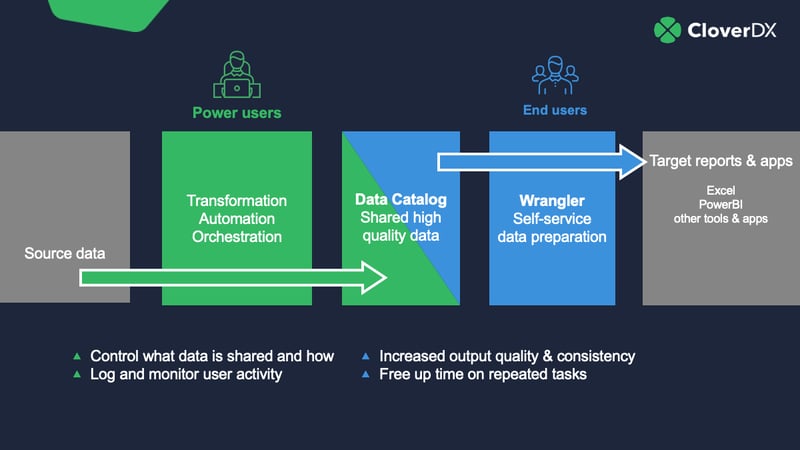Businesses that harness data are 58% more likely to beat their revenue goals. They’re also more likely to retain the trust and business of their customers. With this in mind, it’s no wonder many organizations are keen to move towards a data-driven future.
According to McKinsey, this future looks bright. They expect data-driven organizations in 2025 and beyond to benefit from:
- Real-time data processing and accessibility
- Integrated, ready-to-use data
- Automated data management and security
- Data-driven processes, decision-making, and interactions
These are ambitious goals, but they are worth striving for — and they’re more achievable than you might think. With the right approach, you too can secure the benefits of a data-driven future. And the first step of this process is to build a data-driven culture.
What is a data-driven culture and why does it matter?
A data-driven culture prioritizes factual information over gut instincts. Just as McKinsey envisions, this culture embeds data in every corner of your business and provides the tools and processes needed to utilize it. On a human level, it also requires a mindset shift.
After all, you can collect and validate as much data as you wish, but it won’t have an impact unless you build the right workflows, implement the right training, and support your employees. Without a focus on your people, your technical data processes may fall flat.
By combining technology, processes, and people, you can benefit from a data-driven culture that improves decision-making and reduces costs.
How to build a data-driven culture in 6 steps
Despite its clear benefits, only 20% of organizations say they have developed a data-driven culture. If you’re in the 80% who haven’t, this article is for you.
In six steps, we’ll help you cultivate a data-driven culture:
Step 1: Get everyone onboard
Firstly, we’d like to take a moment to discuss the importance of shared responsibility. While you may naturally associate “data” with your more technical teams, a data-driven culture should be a collective effort.
This means your business users must take responsibility too.
To pass on this responsibility, however, you must improve their data skillset and knowledge. Senior leadership and data experts within your organization should communicate the importance of data quality, collaboration, standardization, and security. They should also back this up with resources and training. Armed with a more data-savvy workforce, your organization will be better prepared to tackle the following steps.
Step 2: Ensure your data is trustworthy
If your data is untrustworthy, your business users will follow one of two routes. They’ll either apply caution and decide not to use it, or they’ll unknowingly place their trust in it. Both scenarios can result in business decisions that are inaccurate.
To ensure trustworthiness, your organization needs to:
- Communicate data formatting and standardization practices.
- Ensure IT can manage data validation and cleansing.
- Adopt automated validation and error handling.
Step 3: Eliminate time-consuming access requests
If business users have to contact the IT department every time they need access to data, they may decide it’s not worth the effort. This can lead to your employees making decisions based on intuition or personal experience alone.
A data-driven culture must break down these barriers and democratize data.
This means providing business users with access to cleansed, validated and curated datasets when they need them — without them having to ask. You’ll also want to ensure that business users can work effectively with this data without the need to reach out to your IT team for support.
Step 4: Allow users to build custom automation
Speeding up access to data is vital, but so too is ensuring your business users can extract insights from it at pace. If they need to perform extensive manual data preparation before they can start their analysis, it’ll make working with data a time-consuming process. They might decide they don’t have the time, or that it’s not worth the effort.
Empowering business users to automate routine data transformations and reports speeds up time-to-insight. They can generate value quickly without wasting hours on repetitive manual tasks or having to seek tech support. Of course, this requires adopting tools that support this automation without the need to code — which many business users may struggle with.
Step 5: Adopt a single, centralized solution
We’re living in the age of application fatigue. Over a third of employees spend 60 minutes a day navigating different apps. In doing so, they often lose their train of thought, suffer dips in productivity, or lose morale.
In a data-driven culture, you should aim to refine — not overload. If you expect your teams to learn the ropes of multiple applications and jump between them daily, you’ll only stress them out. Not to mention, the more data applications you use, the more complicated analysis becomes, and the harder it will be to maintain data quality and consistency.
To reduce time-to-insight, keep morale high, and empower your non-technical users, you should opt for one comprehensive data management platform.
Step 6: Collaborate on a “single source of truth”
We’ve already discussed the importance of bringing data, applications, and teams together.
The final piece of this collaboration puzzle piece is building an accessible “single source of truth”. By this, we refer to a live data catalog that provides a complete overview of your organization’s data. Your IT teams should maintain control over the validation and publication of this data to ensure accuracy and quality. From there, your non-technical users can access data sets and generate insights without any blockers.
Accelerate your data-driven ambitions
You can’t achieve a fully data-driven culture with the latest technology alone. Nor can you achieve it with only written processes and good intentions. A successful data culture is a blend of contributing factors. It requires supporting people-led changes with the right data management platform.
This should be a comprehensive, centralized tool that not only brings your data together but democratizes it.
CloverDX does just that. By providing a comprehensive and user-friendly data integration platform, CloverDX unifies your data, ensures quality through automated workflows, and boosts the productivity and collaboration of your teams. Better still, it’s backed by supportive experts who can help accelerate your data-driven ambitions.
There’s much more to say — and much more we’re eager to show you. To see how it works for yourself, book a demo with our team.










